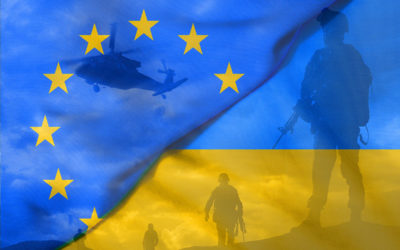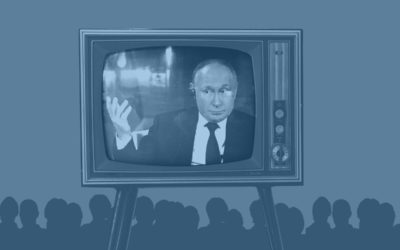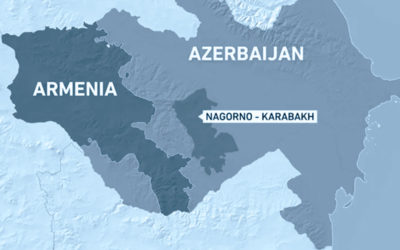Dispatch from Kyiv
27 March 2024

Travelling to Kyiv in 2024 requires a 24 hour trip through 3 different means of transportation. Only 2 and a half years ago, this would’ve been dismissed as pure fiction. But here I was, with a delegation of 30 people from different parts of Europe and the US flying to Warsaw, followed by a 4 hour drive to the Ukrainian border and finally a 12-hour sleeper train that would take of us to the Kyiv Security Forum.
Among the first recommended things to do when going to Ukraine is downloading an air alert app on your phone, which blasts alerts of potential shelling and shows the closest shelter where one can find safety. Sure enough, on the early morning of our arrival to Kyiv on 21st March, 31 missiles were launched on the capital in the biggest attack seen in 44 days, debris of which caused significant damage to roads and civilian buildings.
During the night of 22 March we were awoken, alongside all those living in Ukraine, by a massive attack on the country’s energy infrastructure. A total of 60 drones and 90 missiles were fired, causing major damage to the huge Dnipro hydroelectric power plant. This is Ukraine’s largest, and the one that supplies power to the nuclear plant in Zaporizhzhia. In Kharkiv, almost 1 million people were left without electricity as a result of the attack.
As the Russian Federation was intensifying its attacks on Ukraine, the Kyiv Security Forum was unfolding with local and international guests leading discussions on Ukraine’s prospects of joining the EU and NATO, the country’s internal political dimension, the situation on the frontline and the West’s support to Kyiv.
The loudest message resonating in the room was the need for more military aid – of every type and in every form, from ammunition to air defence. As Admiral Rob Bauer, Chair of NATO’s Military Committee, rightfully pointed out, Ukrainian soldiers are fighting a war combining WWI methods of trenches and artillery barrages with 21st century drones and artificial intelligence. Ukrainian troops are pioneering innovation by using Soviet-style equipment in combination with modern Western material. But they can only continue doing so if more helps comes quickly.
Every passing week, the Kremlin is able to produce more ammunition and missiles than the West thought possible. Somehow, North Korea and Iran can provide military aid to Russia more efficiently than the wealthy and powerful collective West can to Ukraine. Western countries should set clear priorities and ramp up military production by creating partnerships with the private sector to invest in the defence industry.
Today, Ukraine is underarmed and undermanned. During the battle of Avdiivka, the ratio of Russian to Ukrainian soldiers was 7 to 1 according to Colonel Andriy Biletskyi, Commmander of the Third Separate Assault Brigade of the Ground Forces of the Armed Forces of Ukraine. However, victory could’ve been achieved with proper and modern air defence and enough ammunition. The deficit in weaponry leads to difficulties in mobilising troops, therefore leading to even more disparity in the number of soldiers on the frontline.
To successfully continue their task of defending against Russian occupation, the main expectations of the Ukrainian military for 2024 are a viable law on mobilisation from their own government and delivery of necessary military supplies from their allies. Warfare is complicated and multifaceted, and so too is the necessary hardware and weaponry. Air defence systems remain a priority as Russians hold a decisive supremacy in the skies.
However, despite words of support and encouragement from Ukraine’s allies, the situation remains grim. Expressions of condemnation and condolences are not enough. At the moment the world is failing to mobilise the support Ukraine needs, while Russia tries to degrade the resources Kyiv does have.
Some nations do however set a positive example, like Denmark, the first country committing to transfer its entire artillery to Ukraine and urging others to follow. The Baltic states’ bilateral aid to Ukraine from Jan 24, 2022 to Jan 15, 2024 is respectively of 3.6% of GDP for Estonia, 1.5% for Lithuania and 1.2% for Latvia, while the biggest EU Member States are at 0.6%.
With EU and American elections coming up in a few months, 2024 could be a make or break year for Ukraine, and all eyes are on the upcoming Washington Summit. The Deputy Prime Minister of Ukraine, Olha Stefanyshyna, states that Ukraine has expectations but no illusions, as the only commitment from NATO allies is a recurrent message of “Ukraine will become a member of NATO, it’s not a question of if but of when”.
One thing is clear, neutrality does not guarantee peace and grey zones are a danger for international security. While writing this piece, two more air strikes were carried out by Russia on Kyiv and Lviv on 24 and 25 March.
Ukraine is fighting for its rightful place in the EU and NATO as a full-fledged member among democracies in the collective West, but its chance of survival depends on the timely delivery of military aid from its allies.
ENJOYING THIS CONTENT?





















